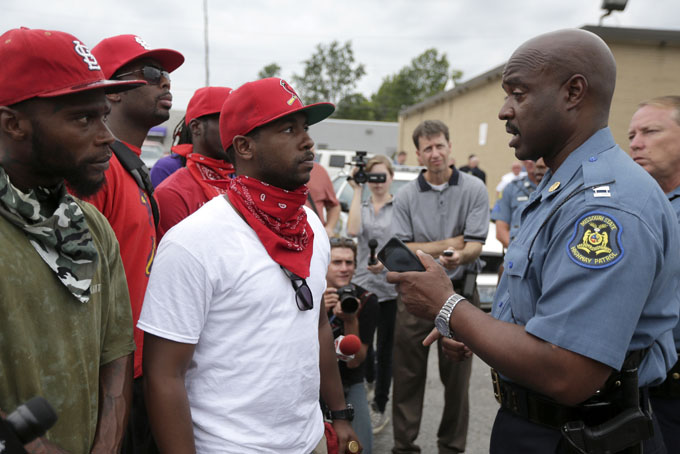
FERGUSON, Mo. (AP) — In the days since Missouri Highway Patrol Capt. Ron Johnson took charge of a volatile situation that threatened to turn ugly, tragic or both, his calm-yet-commanding presence has captured international attention. But when it comes to keeping the peace in the St. Louis suburb where a White police officer shot and killed an unarmed Black teen, Johnson knows his neighbors’ opinions are what matter most.
“The people of our community need to hear what I’m saying,” Johnson, who is Black, said at the start of one daily press briefing, urging local residents standing behind an enormous media contingent to come closer to the podium. “They’ve got questions, and I invited them here.”
The 27-year patrol veteran, who oversees nearly 150 troopers patrolling 11 counties in eastern Missouri, grew up down the road from the neighborhood where 18-year-old Michael Brown was killed Aug. 9. He still lives nearby, in the neighboring town of Florissant. He was placed in charge of Ferguson security by Col. Ron Repogle, the Highway Patrol superintendent, after Gov. Jay Nixon revoked county police oversight Thursday.
Johnson’s impact was immediate. After five nights of volatile and violent protests marked by looting, arson and the use of tear gas on demonstrators by county and local police, Johnson ordered his officers to abandon the body armor and gas masks and instead ensure the public’s right to peaceably assemble.
Things escalated again Friday night, after Ferguson police released the name of the officer who shot Brown along with video they said showed the teen robbing a store shortly before he was killed. But as looters broke into several businesses, some throwing rocks and other objects at officers, police backed off, a move Johnson said was designed to ease tension. No arrests were made and no one was badly hurt.
From the start, Johnson, 50, walked alongside protesters, past the barbecue joint and neighborhood taverns he knew by name, stopping for hugs, handshakes and encouragement. He spoke sincerely and empathetically with young black men who described routine racial profiling based on their clothing, hairstyles and demeanor. Their complaints were familiar: His own son, in his 20s, is often judged because of his tattoos, Johnson said.
Most of all, he listened.
“He made himself accessible, from a place of peace and understanding,” said Robin Moore-Chambers, a diversity trainer and counseling professor at Lindenwood University who lives in nearby Dellwood. “He’s listening to everybody. He will take you seriously. He’s appealing to their humanity. He knows they need to be heard.”
Protesters and politicians credit him with almost entirely defusing the nightly violence, and giving the community a sense that it can recover.
On Saturday, Johnson was front and center at a volatile news conference with the governor, taking the lead in explaining how a curfew Nixon ordered would be carried out.
“What we’re doing now is not who we are. It’s not who we are. Yelling at each other is not going to solve it,” Johnson calmly told one audience member. “We’re all talking about the same concerns and the same passion. The frustration that’s in your home is in my home. It’s in my home. And I’ve given you all the answers that I know, and I’m going to continue to give you that.”
Johnson said police would not use armored trucks and tear gas. He also credited community leaders who had voluntarily helped maintain order in the streets and discourage protesters from violence.
Complaints about the police response began almost immediately after Brown’s shooting, when authorities decided to use dogs for crowd control — a tactic that for some evoked civil-rights protests from a half-century ago. The county police had taken over at the request of the smaller city, leading both the investigation of Brown’s shooting and the subsequent attempts to keep the peace until the state stepped in.
Johnson joined the Highway Patrol in 1987, earning a promotion to corporal in 1995 and to sergeant two years later. He spent three years on the other side of the state after a promotion to lieutenant in 1999 before returning to the St. Louis region as commanding officer in 2002.
Law enforcement runs in the family. St. Louis Police Chief Sam Dotson told the St. Louis Post-Dispatch that Johnson’s father-in-law was a deputy police chief for the city department.
While Johnson’s role has been largely welcomed, not everyone is satisfied. Some residents asked if he was simply a figurehead, noting Johnson was not aware Ferguson’s police chief would release the surveillance footage of Brown, part of what led to the renewed unrest Friday. Johnson assured them that “we’re all in this together.”
“We all want justice. We all want answers,” he said. “I’ve got a big dog in this fight. When the media is gone … Ron Johnson is still going to be here.”
___
Follow Alan Scher Zagier on Twitter at https://twitter.com/azagier